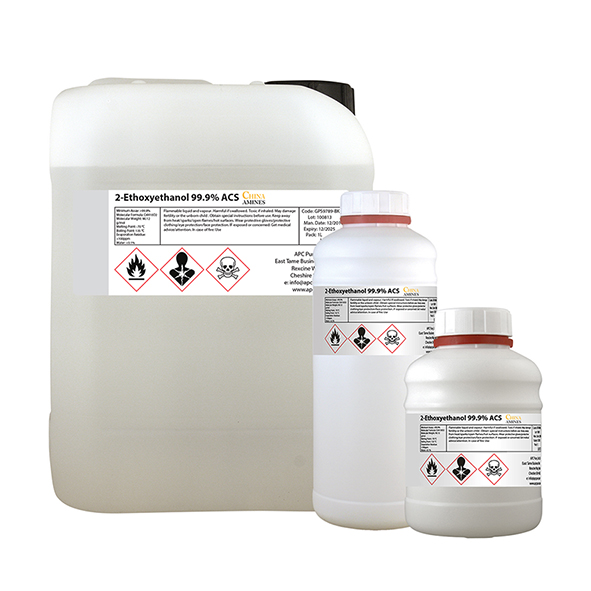1. Chemical Structure and Properties
Molecular Formula: C₄H₁₀O₂
Structural Formula:
HO-CH₂CH₂-O-CH₂CH₃
A glycol ether composed of an ethylene oxide unit linked to an ethyl group, terminated by a hydroxyl group.
Physical Properties:
Appearance: Clear, colorless liquid with a mild, slightly sweet odor.
Boiling Point: 135°C; Density: 0.93 g/cm³; Vapor Pressure: 3.2 mmHg at 25°C.
Solubility: Fully miscible with water, alcohols, and most organic solvents (e.g., acetone, ether).
Chemical Properties:
Hydrolysis Stability: Stable under neutral conditions; hydrolyzes in strong acids/bases to ethylene glycol and ethanol.
Thermal Stability: Decomposes above 200°C, releasing aldehydes and ethylene oxide.
Flammability: Combustible (flash point: 44°C; autoignition temperature: 235°C).
2. Industrial Applications
Coatings & Inks:
Coalescing Agent: Enhances film formation in waterborne paints, latex adhesives, and printing inks.
Solvent: Dissolves resins, dyes, and cellulose derivatives in industrial coatings.
Electronics:
Photoresist Stripper: Cleans residues from semiconductor wafers and circuit boards.
Cleaning Products:
Industrial Degreaser: Removes oils, greases, and waxes in aerospace and automotive applications.
Chemical Synthesis:
Intermediate: Produces surfactants, plasticizers, and specialty esters.
3. Safety and Toxicology
Acute Exposure:
Inhalation (≥25 ppm): Irritates respiratory tract; causes dizziness and headaches (TLV-TWA: 5 ppm).
Skin Contact: Causes irritation and dermatitis (rabbit skin LD₅₀: 1,200 mg/kg); readily absorbed through skin.
Ingestion: Moderately toxic (oral LD₅₀ rat: 3,000 mg/kg); gastrointestinal and central nervous system effects.
Chronic Effects:
Reproductive Toxicity: Linked to developmental and fetal toxicity (EU CLP: Repr. 1B (H360D)).
Hematotoxicity: May cause bone marrow suppression and anemia in prolonged exposure.
Protection Measures:
PPE: Nitrile gloves, chemical goggles, and vapor respirators.
Storage: Store in sealed, flame-resistant containers away from oxidizers and heat sources.
4. Environmental and Regulatory Compliance
Environmental Impact:
Biodegradability: Moderate (OECD 301F: 40–60% degradation in 28 days).
Aquatic Toxicity: LC₅₀ (fish, 96h): 50–100 mg/L; EC₅₀ (daphnia, 48h): 30–50 mg/L.
Bioaccumulation: Low (log Kow: -0.8).
Regulatory Frameworks:
EU:
REACH: Restricted in consumer products (Annex XVII); CLP classified as Repr. 1B (H360D).
USA:
EPA: Regulated under TSCA; listed as a hazardous air pollutant (HAP).
OSHA: PEL: 5 ppm (8-hour TWA).
China:
GB 13690-2009: Classified as Hazardous Chemical (Class 6.1).
Waste Management:
Incinerate in licensed facilities with VOC abatement; landfill disposal prohibited.
5. Case Studies and Application Insights
Case 1: Sustainable Waterborne Paints (PPG, 2023):
Challenge: Reduce VOC emissions in architectural paints without compromising drying time.
Solution: Replaced 20% of 2-ethoxyethanol with bio-based glycol ethers.
Result: Achieved 30% lower VOC emissions (ASTM D6886) and maintained scrub resistance (ASTM D2486).
Case 2: Aerospace Cleaning Reformulation (Boeing, 2022):
Process: Eliminated 2-ethoxyethanol from engine degreasers using terpene-based solvents.
Impact: Reduced worker exposure risks by 90% and met Boeing D6-17487P safety standards.
Comparative Analysis:
2-Ethoxyethanol vs. Propylene Glycol Methyl Ether (PGME):
Pros: Superior solvency for polar resins; lower cost.
Cons: Higher reproductive toxicity and regulatory restrictions.
2-Ethoxyethanol vs. Ethyl Lactate:
Pros: Faster evaporation; better compatibility with hydrophobic substrates.
Cons: Ethyl lactate is biodegradable and non-toxic but less effective for heavy degreasing.
Specifications:
2-Ethoxyethanol, also known by the trademark Ethyl cellosolve, is a solvent used widely in commercial and industrial applications. It is a clear, colorless, nearly odorless liquid that is miscible with water, ethanol, diethyl,ether, acetone, and ethyl acetate.
2-Ethoxyethanol is manufactured by the reaction of ethylene oxide with ethanol.
As with other glycol ethers, 2-ethoxyethanol has the useful property of being able to dissolve chemically diverse compounds. It will dissolve oils, resins, grease, waxes, nitrocellulose, and lacquers. This is an ideal property as a multi-purpose cleaner, and, therefore, 2-ethoxyethanol is used in products such as varnish removers and degreasing solutions.



